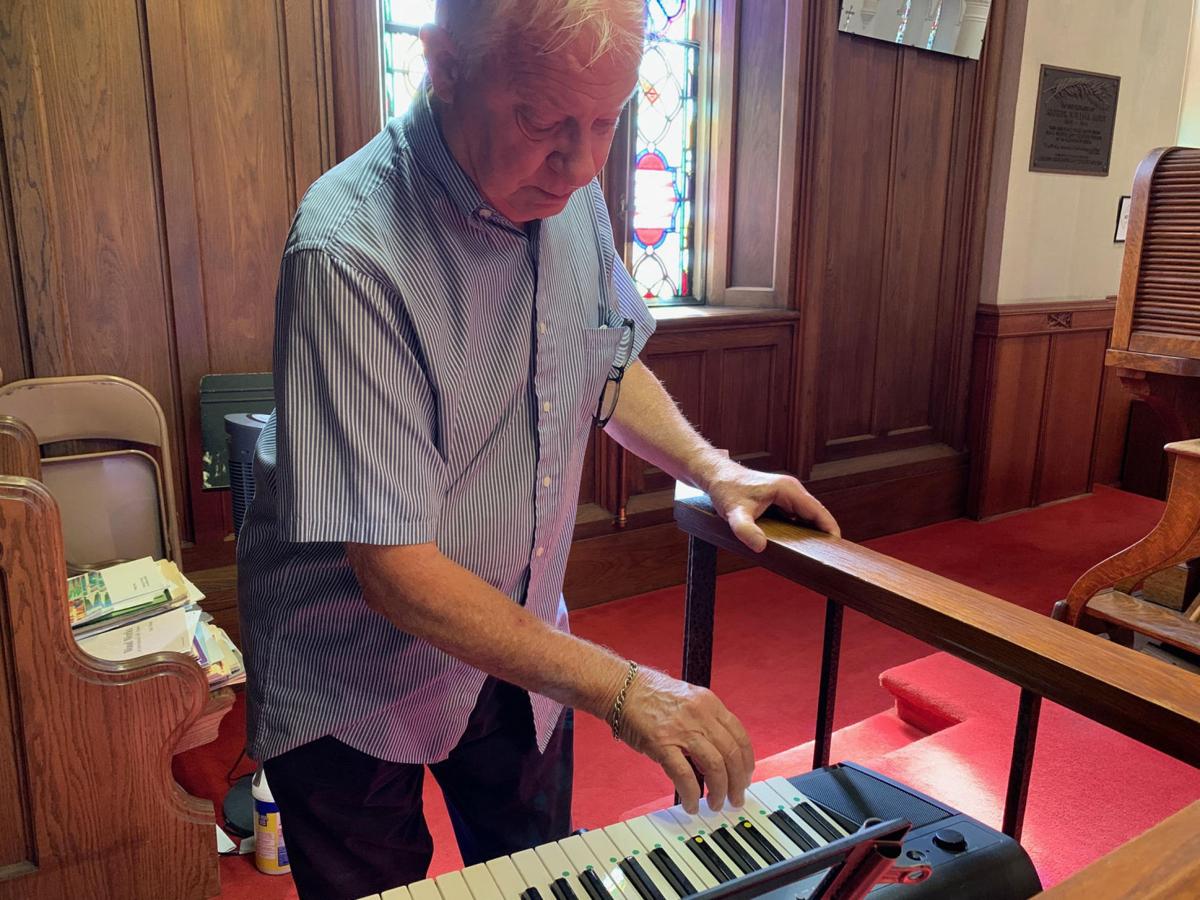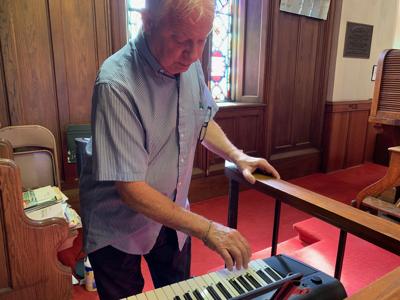St. Matthew’s Episcopal Church carillon concert fills the air

Jim Winfield, director of music at St. Matthew Episcopal Church, performed a concert playing the carillon and organ with the addition of a virtual choir, on Aug. 9. The music played out from the St. Matthew bell tower in Library Square in downtown Kenosha. The choir prepared its tracks at home to music and Father Matthew Buterbaugh, pastor of St. Matthew’s, merged the tracks into the single choir.
Those meandering around Library Square on Saturday morning, Aug. 9, may have heard the delightful melodic tones of carillon bells playing some familiar sacred tunes flowing from the bell tower of St. Matthew Episcopal Church.
Listening to a carillon is an immersive experience; the crisp tones rebound off rooftops and through trees, creating an organic resonance in tune with nature, far removed from the antiseptic perfection of a recording studio or even the perfect acoustics of a performance hall.
Jim Winfield, director of music at St. Matthew’s, performed the concert playing the carillon and organ with addition of a virtual choir. The choir prepared its tracks at home to music and Father Matthew Buterbaugh, pastor of St. Matthew’s, merged the tracks into a single choir.
The concert was in celebration of the August 6 Feast of the Transfiguration of Christ when Jesus was transfigured into dazzling white and became radiant in glory upon a mountain.
History of church bells
Historically, church bells served as clocks, summonses and warning systems. They clamored in celebration and knelled in condolence. Bells typically made noise, not music.
It wasn’t until the late 16th century in the Low Countries of Flanders, Netherlands or Belgica that bells were used to play melodic musical compositions.
The first carillon was in Flanders where a court jester performed music on the bells of an Oudenaarde Town Hall in 1510 by using a baton keyboard.
Traditionally a carillon is a musical instrument composed of tuned bronze bells which are played by using a baton keyboard. Following the instrument’s invention, the carillon was installed in hundreds of towers around Europe.
In 1883, the Church of the Holy Trinity in Philadelphia received its first carillon. Soon after, churches and colleges across the country began ordering their own carillons from the bell foundries of Europe. The first carillon school was founded in Belgium just prior to the 10th century.
St. Matthews’s bell goes back to 1943
St. Matthew’s have used bells to call worshipers to services since 1843. A 35- pound bell, made by the Holbrook Foundry in Massachusetts still resides in the tower and is run on Sunday mornings. The bell was the first in Southport and only the third bell in the Northwest Territory. When the bell was first installed, it rang continuously for 24 hours.
In 1894, three more bells cast by the Menelly Foundry in New York were added. They weighed 550, 250, and 150 pounds respectively and attached to the church’s Seth Thomas Tower Clock. They ring on the hour and quarter hour.
One hundred years later, 14 bells were added, making a choir of bells. Unlike the traditional baton keyboard, St. Matthew’s carillon consists of a regular one octave (8 notes) keyboard with one sharp and one flat.
“The keyboard is connected to the tower and operates the bells when I depress the keys,” said Winfield. “Playing it is similar to playing the piano, but I have to be careful what I play since there is only a little more than an octave, so I have to play pieces to accommodate those notes.”
Skinner organ nears centennial
Winfield performed three of the pieces on the church’s Skinner Organ, purchased in 1924 for $29,800 from the Ernest Skinner Organ Company of Boston, Mass.. The organ was installed in 1925, under the supervision of E.M. Skinner himself. It has been estimated that today it would cost close to $600,000 to replace the Skinner organ in St. Matthew’s.
The Skinner organs were characterized by their excellent craftsmanship, great warmth of tone and lush romantic sound. Skinner Organs grace the campuses of Yale and Princeton as well as many churches all across the country.
“This is a great gem of an organ,” said Winfield. “I am privileged to be able to play it.”
For services, Winfield normally plays the organ, but he is hoping to start playing the carillon after services.
“I was thinking of playing it every Sunday morning after postlude and could give people a nice goodbye,’ he said.
About Winfield
Winfield has served as St. Matthew’s director of music about a year ago after an interim period, explained Buterbaugh.
“He is a very gifted musician and director. While Jim is Episcopalian, he has served most of his career in music ministry in Congregationalist churches. He semi-retired and moved to Kenosha, before coming out of retirement to serve at St. Matthew’s,” he explained. “We feel very blessed to have him working with us. During this time of pandemic and social distancing, he has been wonderful about learning how to direct music remotely and (is always) coming up with creative ways to do worship. Not only is he talented, but a pleasure to work with.”
Winfield earned his Bachelor of Music in Organ and Conducting from the Indiana School of Music. He sang professionally for seven years, began a community chorus and conducted the West Suburban Symphony Orchestra from 1988-1996.
“It was all tremendous fun, but every good thing comes to an end,” he said. “I sort of semi-retired and moved here about four or five years ago. I was raised Episcopal and saw that St. Matthew’s was looking for a music director and organist. It came full circle.”
The entire concert, complete with a short message by Fr. Matthew Buterbaugh was recorded is available on a YouTube link: https://www.youtube.com/watch?v=S3enygn8bKA.












Recent Comments